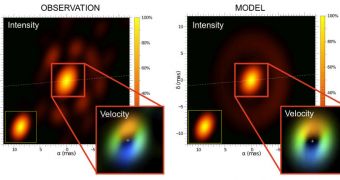After several years of continued observations, a supergiant star has finally revealed its most intimate secret – why is it that it has a disk containing cosmic dust and hydrogen gas around it.
Generally, such disks only develop around young stars. They are called protoplanetary disks, because they have the potential to form companions for the new stars, such as for example asteroid belts, rocky planets, gas giants, comets, asteroids, and so on.
But it's really unusual for such a disk to exist around an older, supergiant star, partially because of the intensity of solar winds. Their strength should theoretically destroy the disk over very short periods of time, yet a handful of such celestial fireballs have been detected thus far.
The supergiant HD 62623 is one of these peculiar bodies, but its secrets were recently discovered using the AMBER long-baseline stellar interferometer instrument on a telescope in Chile.
This tool works extremely well for producing three-dimensional images of various cosmic objects, and this is exactly what it did for the supergiant. The observations campaign reveals that the star has a companion, which is most likely responsible for supporting the disk as we see it today.
The researchers used the Very Large Telescope interferometer for the investigations. The facility is operated by the European Southern Observatory in La Silla, Chile, at the edge of the Atacama desert.
“Thanks to our interferometric observations with Amber we could synthesize a 3D image of HD 62623 as seen through a virtual 130 meter-diameter telescope,” explains expert astronomer Florentin Millour.
“The resolution is an order of magnitude higher compared with the world’s largest optical telescopes of 8-10-meter diameter,” adds the scientist, who is based at the Observatoire de la Côte d’Azur. He is also the leading author of the new study.
The researcher adds that HD 62623 is part of a class containing some of the most massive stars in the Universe, which tip the scale at 10 to 70 solar masses. The only stars that are more massice are hypergiants, which weigh in at 100 to 265 solar masses.
“Our new 3D image locates the dust-forming region around HD 62623 very precisely, and it provides evidence for the rotation of the gas around the central star,” explains scientist Anthony Meilland, quoted by Universe Today.
“This rotation is found to be Keplerian, the same way the Solar system planets rotate around the Sun,” adds the expert, who is a coauthor of the investigation, and based at the Max Planck Institute for Radio Astronomy (MPIA).

 14 DAY TRIAL //
14 DAY TRIAL //